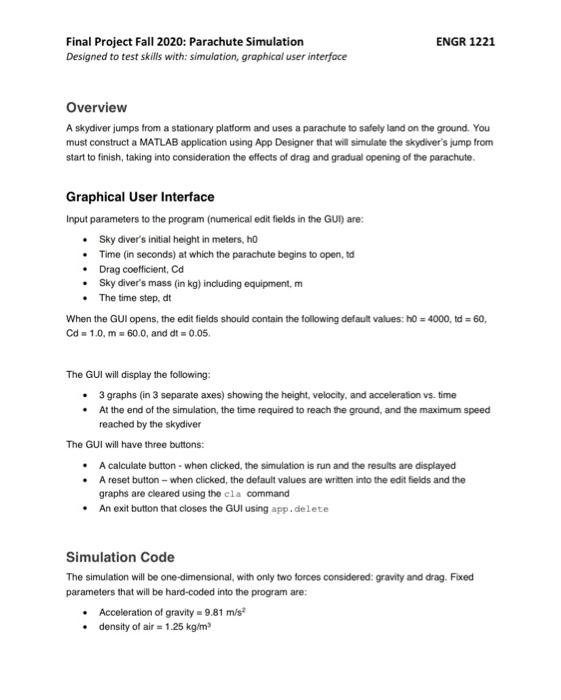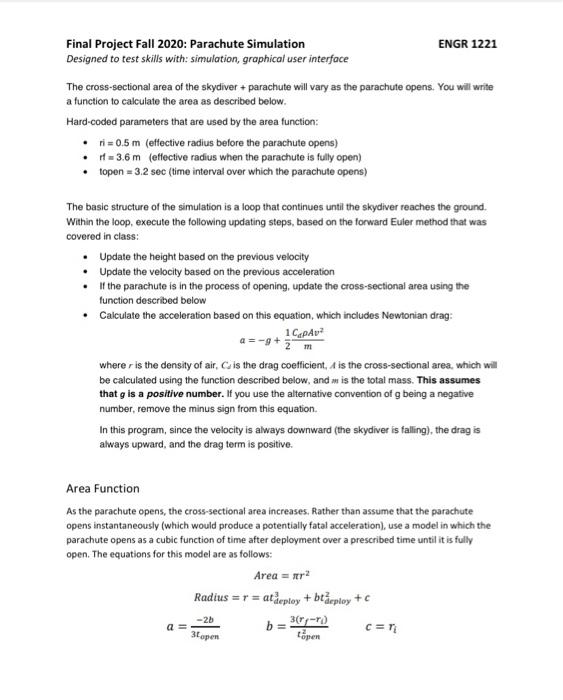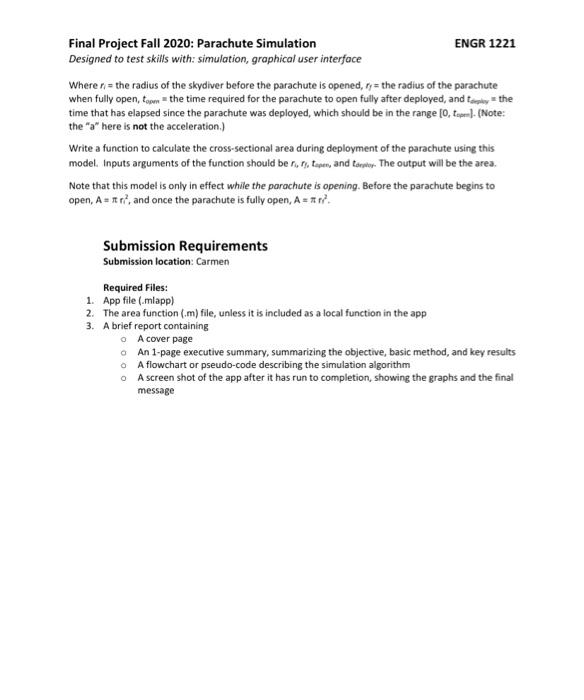In MATLAB please

Final Project Fall 2020: Parachute Simulation Designed to test skills with: simulation, graphical user interface ENGR 1221 Overview A skydiver jumps from a stationary platform and uses a parachute to safely land on the ground. You must construct a MATLAB application using App Designer that will simulate the skydiver's jump from start to finish, taking into consideration the effects of drag and gradual opening of the parachute. Graphical User Interface Input parameters to the program (numerical edit fields in the GUI) are: Sky diver's initial height in melers, ho Time (in seconds) at which the parachute begins to open, td Drag coefficient, Cd Sky diver's mass (in kg) including equipment, m The time step, at When the GUI opens, the edit fields should contain the following default values: ho = 4000, td = 60, Cd = 1.0, m = 60.0, and dt -0.05. The GUI will display the following: 3 graphs (in 3 separate axes) showing the height, velocity, and acceleration vs. time At the end of the simulation, the time required to reach the ground, and the maximum speed reached by the skydiver The GUI will have three buttons: A calculate button - when clicked, the simulation is run and the results are displayed A reset button - when clicked, the default values are written into the edit fields and the graphs are cleared using the cla command An exit button that closes the GUI using app.delete Simulation Code The simulation will be one-dimensional, with only two forces considered: gravity and drag. Fixed parameters that will be hard-coded into the program are: Acceleration of gravity = 9.81 mis? density of air = 1.25 kg/m Final Project Fall 2020: Parachute Simulation ENGR 1221 Designed to test skills with: simulation, graphical user interface The cross-sectional area of the skydiver + parachute will vary as the parachute opens. You will write a function to calculate the area as described below. Hard-coded parameters that are used by the area function: . r=0.5 m (effective radius before the parachute opens) H=3.6m (effective radius when the parachute is fully open) topen = 3.2 sec (time interval over which the parachute opens) The basic structure of the simulation is a loop that continues until the skydiver reaches the ground. Within the loop, execute the following updating steps, based on the forward Euler method that was covered in class: Update the height based on the previous velocity Update the velocity based on the previous acceleration If the parachute is in the process of opening, update the cross-sectional area using the function described below Calculate the acceleration based on this equation, which includes Newtonian drag: 1 CPAP a=-9+ wherer is the density of air, C is the drag coefficient, A is the cross-sectional area, which will be calculated using the function described below, and m is the total mass. This assumes that g is a positive number. If you use the alternative convention of g being a negative number, remove the minus sign from this equation. In this program, since the velocity is always downward (the skydiver is falling), the drag is always upward, and the drag term is positive. Area Function As the parachute opens, the cross-sectional area increases. Rather than assume that the parachute opens instantaneously (which would produce a potentially fatal acceleration), use a model in which the parachute opens as a cubic function of time after deployment over a prescribed time until it is fully open. The equations for this model are as follows: Area = sera Radius =r= atdeploy + teploy + c -2b a 3topen Ppen Final Project Fall 2020: Parachute Simulation ENGR 1221 Designed to test skills with: simulation, graphical user interface Wheren= the radius of the skydiver before the parachute is opened, r = the radius of the parachute when fully open to the time required for the parachute to open fully after deployed, and to the time that has elapsed since the parachute was deployed, which should be in the range [0, tel. (Note: the "a" here is not the acceleration) Write a function to calculate the cross-sectional area during deployment of the parachute using this model. Inputs arguments of the function should be r, 1 tower, and torney. The output will be the area. Note that this model is only in effect while the parachute is opening. Before the parachute begins to open, Astri, and once the parachute is fully open, A=. Submission Requirements Submission location: Carmen Required Files: 1. App file (mlapp) 2. The area function (m) file, unless it is included as a local function in the app 3. A brief report containing A cover page An 1-page executive summary, summarizing the objective, basic method, and key results A flowchart or pseudo-code describing the simulation algorithm A screen shot of the app after it has run to completion, showing the graphs and the final message Final Project Fall 2020: Parachute Simulation Designed to test skills with: simulation, graphical user interface ENGR 1221 Overview A skydiver jumps from a stationary platform and uses a parachute to safely land on the ground. You must construct a MATLAB application using App Designer that will simulate the skydiver's jump from start to finish, taking into consideration the effects of drag and gradual opening of the parachute. Graphical User Interface Input parameters to the program (numerical edit fields in the GUI) are: Sky diver's initial height in melers, ho Time (in seconds) at which the parachute begins to open, td Drag coefficient, Cd Sky diver's mass (in kg) including equipment, m The time step, at When the GUI opens, the edit fields should contain the following default values: ho = 4000, td = 60, Cd = 1.0, m = 60.0, and dt -0.05. The GUI will display the following: 3 graphs (in 3 separate axes) showing the height, velocity, and acceleration vs. time At the end of the simulation, the time required to reach the ground, and the maximum speed reached by the skydiver The GUI will have three buttons: A calculate button - when clicked, the simulation is run and the results are displayed A reset button - when clicked, the default values are written into the edit fields and the graphs are cleared using the cla command An exit button that closes the GUI using app.delete Simulation Code The simulation will be one-dimensional, with only two forces considered: gravity and drag. Fixed parameters that will be hard-coded into the program are: Acceleration of gravity = 9.81 mis? density of air = 1.25 kg/m Final Project Fall 2020: Parachute Simulation ENGR 1221 Designed to test skills with: simulation, graphical user interface The cross-sectional area of the skydiver + parachute will vary as the parachute opens. You will write a function to calculate the area as described below. Hard-coded parameters that are used by the area function: . r=0.5 m (effective radius before the parachute opens) H=3.6m (effective radius when the parachute is fully open) topen = 3.2 sec (time interval over which the parachute opens) The basic structure of the simulation is a loop that continues until the skydiver reaches the ground. Within the loop, execute the following updating steps, based on the forward Euler method that was covered in class: Update the height based on the previous velocity Update the velocity based on the previous acceleration If the parachute is in the process of opening, update the cross-sectional area using the function described below Calculate the acceleration based on this equation, which includes Newtonian drag: 1 CPAP a=-9+ wherer is the density of air, C is the drag coefficient, A is the cross-sectional area, which will be calculated using the function described below, and m is the total mass. This assumes that g is a positive number. If you use the alternative convention of g being a negative number, remove the minus sign from this equation. In this program, since the velocity is always downward (the skydiver is falling), the drag is always upward, and the drag term is positive. Area Function As the parachute opens, the cross-sectional area increases. Rather than assume that the parachute opens instantaneously (which would produce a potentially fatal acceleration), use a model in which the parachute opens as a cubic function of time after deployment over a prescribed time until it is fully open. The equations for this model are as follows: Area = sera Radius =r= atdeploy + teploy + c -2b a 3topen Ppen Final Project Fall 2020: Parachute Simulation ENGR 1221 Designed to test skills with: simulation, graphical user interface Wheren= the radius of the skydiver before the parachute is opened, r = the radius of the parachute when fully open to the time required for the parachute to open fully after deployed, and to the time that has elapsed since the parachute was deployed, which should be in the range [0, tel. (Note: the "a" here is not the acceleration) Write a function to calculate the cross-sectional area during deployment of the parachute using this model. Inputs arguments of the function should be r, 1 tower, and torney. The output will be the area. Note that this model is only in effect while the parachute is opening. Before the parachute begins to open, Astri, and once the parachute is fully open, A=. Submission Requirements Submission location: Carmen Required Files: 1. App file (mlapp) 2. The area function (m) file, unless it is included as a local function in the app 3. A brief report containing A cover page An 1-page executive summary, summarizing the objective, basic method, and key results A flowchart or pseudo-code describing the simulation algorithm A screen shot of the app after it has run to completion, showing the graphs and the final message










